The very first piece of Tarzan's attire is revealed in Tarzan Of The Apes, chapter 5. It was the grass rope that he learned to form early in his boyhood. Shortly after, at the age of ten, the ape boy managed to enter the cabin where he had laid his hands on his father's hunting knife, chapter 6. Exactly when little Tarzan forms the self-fashioned sheath is not told, but he has one at about thirteen when he kills Tublat, his foster father, chapter 7.
In chapter 9, at the age of eighteen, Tarzan kills the murderer of his foster mother and in the process takes his bow and quiver of arrows. Also taken were the black's knife and sheath, and copper anklet. Kulonga's headdress was also taken, and it was used in the first of Tarzan's jungle jokes in chapter 10. Nothing is said about Tarzan taking Kulonga's loincloth, nor do any later passages indicate that he did so. This has puzzled many scholars for a number of passages indicate the ape-man desperately wanted to be clothed.
"At the bottom of his little English heart beat the great desire to cover his nakedness with clothes for he had learned from his picture books that all men were so covered, while monkeys and apes and every other living thing went naked." ERB-Tarzan Of The Apes.
"Clothes, therefore, must be truly a badge of greatness; the insignia of the superiority of man over all other animals, for surely there could be no other reason for wearing the hideous things," ERB-Tarzan Of The Apes, chapter 7.
With the killing of Tublat, however, Tarzan's attitude began to change somewhat. "Many moons ago, when he had been smaller, he had desired the skin of Sabor, the lioness, or Numa, the lion., or Sheeta, the leopard, to cover his hairless body that he might no longer resemble hideous Hista, the snake; but now he was proud of his sleek skin for it betokened his descent from a mighty race, and the conflicting desires to go naked in prideful proof of his ancestry, or to conform to the customs of his own kind and wear hideous and uncomfortable apparel found first one then the other in the ascendancy," ERB-Tarzan Of The Apes, chapter 7.
%20Zedenek%20Burian-5.jpg) |
| Zdenek Burian |
From this passage, we know Tarzan is no longer ashamed of his bare flesh, so therefore, he has now developed split feelings on whether he wants to clothe himself or not. It is not until the great storm that Tarzan's mind comes to a final decision.
"But to Tarzan a dawning light had come to explain the mystery of clothes. How snug he would have been beneath the heavy coat of Sabor! And so was added a further incentive to the adventure," ERB-Tarzan Of The Apes, chapter 7.
 |
| Joe Kubert |
Now we are back to the original question. If Tarzan wanted clothes so bad why didn't he take Kulonga's? True, Kulonga's loincloth would have been a prized possession, but there was one Tarzan desired even more. The above passages indicate Tarzan's desire from childhood, is to one day kill a cat with his own powers, and form its skin into clothes. If the ape boy could indeed complete this goal he would accomplish several things.
 |
| Joe Kubert |
The killing of a cat, which he has not done yet, would fulfill his childhood dreams of becoming the conqueror of the deadliest enemy to his people and the killer of many of his old friends. It would raise his rapidly rising self-confidence to even greater heights. It would prove him a mighty hunter and fighter, which in turn would raise his status among the bulls. The cat loincloth would be a constant reminder to the Mangani of his superiority over them. It would also be a reminder to Kerchak, the king, that he was no longer Kala's, frail bula, but now a potential challenger for his kingship. Finally, it would fulfill his desire to be clothed like a man.
The taking of Kulonga's loincloth would represent nothing but clothing himself like a man. The bow and arrows would easily overshadow the doeskin covering in the Mangani's eyes. If the ape boy had known anything about tanning it's most probable he would have taken Kulonga's loincloth. It is not until chapter 6, of Jungle Tales Of Tarzan, that he discovers that a tanning process is required to make skins suitable for wearing.
From when Tarzan confiscated Kulonga's bow and other belongings most misled chronologists automatically assume that they become part of his regular apparel, but this is not the case. In no passage does Edgar Rice Burroughs directly tell us this, or even hint at it. Naturally, Tarzan put them on and wore them constantly for the first few days, because they were spoils of victory and objects of man.
Upon first putting on Kulanga's headdress, sheath, belt, and copper anklet the ape-man felt a feeling of confinement. He had been nude all his life except for the homemade knife sheath and grass rope. Once the bow and quiver of arrows were added he felt like an old dog with a collar on for the first time. When the jungle lord traveled through the trees he soon discovered the headdress was a hamper and this is one of the main reasons he used it in his first joke on the natives.
The copper anklet constantly bounced around on his ankle and was irritating, but at least it was endurable. The belt and sheath too must have been aggravating because in a later event when Tarzan renounces his kingship and goes to live in the Greystoke's cabin, he has discarded them. "About his waist was a belt of tiny strips of rawhide fashioned by himself as a support for the homemade scabbard in which hung his father's hunting knife." ERB-Tarzan Of The Apes, chapter 13.
After exiting Mbonga's village Tarzan stopped off and got the bow and quiver of arrows he had hidden. Like the headdress, the bow and arrows were nothing but a hassle while traveling through the trees, but he knew the opportunities they offered. The bow constantly snagged branches and the quiver of arrows bounced around worse than the anklet, not to mention the noise they made due to his type of travel.
These new items, plus his rope, presented quite a wardrobe. One that made the ape-man feel very uncomfortable and entrapped. They often hampered his movement. Agility was one of Tarzan's most valuable weapons. So, it was only a short time after displaying his confiscated possessions to the Mangani that the newness wore off and the jungle lord stored them away.
 |
| Tarzan Of The Apes |
Edgar Rice Burroughs tells us the night Tarzan steals Kulonga's bow and arrows, Tarzan Of The Apes, chapter 7, that he took them to the very top of a giant tree and hid them. The author describes Tarzan's marking of the tree, as it being common practice. Possessions not in use were stored in caches like this near the tribe's nightly stops if they were any great distance from the cabin. This only happened once in a great while, because Edgar Rice Burroughs tells us that hunting was good in the area during this period.
The majority of the time the ape-man stored his treasures at the Greystoke cabin located by the sea. We know this from the description Edgar Rice Burroughs provides in chapter 13 of Tarzan Of The Apes when the Porter mutineers beached and ransacked Tarzan's cabin.
The next addition to the jungle lord's wardrobe is his mother's locket which he finds in chapter 11 of Tarzan Of The Apes. It is never directly stated, but there is a good chance the locket was also stored in the cabin most of the time, after a short time of constant wearing. The locket is not mentioned in Jungle Tales Of Tarzan.
Although not continuously adorned with these new possessions Tarzan did enjoy dressing up like a man from time to time. Most of this, however, was done while he was at the cabin where he divided his time reading and practicing with his newly acquired weapons.
Though Tarzan became very interested in his bow and practiced with it every day, it did not immediately become a primary weapon. At the time Jungle Tales Of Tarzan begins the ape-man had the bow for only two months. We know Tarzan was beginning to become a pretty fair shot, but at this time he still considered his new weapon a toy with future potential.
The ape-man was just getting the feel of the bow and could pretty well hit a stationary target, but he was not yet good enough to hit a small moving game constantly. Tarzan often hunted with his bow, but it was more of a leisure thing, to test his developing skills. When Tarzan's belly was hungry and he was really in need of food the ape-man still depended on his knife and grass rope.
Nowhere in the jungle lord's first three recorded visits to Mbonga's village does Edgar Rice Burroughs say anything about him taking a spear. Upon Tarzan's first trip to Mbonga's village, the author says, "He determined to own one of these long, pointed sticks, but he could not take one on this trip because of the arrows he meant to carry," Tarzan Of The Apes, chapter 10.
We do know that Tarzan did get a spear sometime during one of his early visits, and practiced regularly with it just like he did with his bow. It is first mentioned in Jungle Tales Of Tarzan, chapter 5, where the ape-man uses a spear to help kill a lion that is attacking Tibo and his mother. This event occurs even before Tarzan kills Sabor, the lioness, with his bow in chapter 11 of Tarzan Of The Apes. The description clearly shows the jungle lord has gained sufficient skills in its use by the time it is first mentioned.
Like the spear, nothing is mentioned about Tarzan's first time obtaining a shield. We do know the jungle lord possesses some because of the statement made in chapter 13 of Tarzan Of The Apes. "His weapons and shields and other little stores of treasures were littered about."
 |
| Joe Kubert |
Besides this first barrage of weapons, Tarzan steadily collects numerous others from Mbonga's warriors throughout the two-year event of Jungle Tales Of Tarzan. In chapter 13 of Tarzan Of The Apes, we learn these weapons are also stored at the cabin. "Then gathering up his precious tin box, his arrows, and as many bows and spears as he could carry, he hastened through the door and disappeared into the forest."
Besides being a hindrance, there is another often-overlooked reason why Tarzan stored his possessions in the cabin and seldom took them around the Mangani. In chapter 1 of Jungle Tales Of Tarzan, the ape-man discovers Taug has been captured by Mbonga's warriors. Tarzan then races back to the tribe where he startles them with his sudden appearance. "Tarzan noticed this as he had noticed it many times in the past - that always his sudden coming among them left them nervous and unstrung for a considerable time, and that they one and all found it necessary to satisfy themselves that he was indeed Tarzan by smelling about him a half dozen or more times before they calmed down."
Edgar Rice Burroughs constantly informs us that Kerchak's tribe does not consider Tarzan one of them. They more or less see him as a friendly outsider who has been adopted by the tribe. Like all jungle beasts, the Mangani are very cautious and depend more on their smell than sight. Eyes are often tricked but seldom is the smell. So, to satisfy their suspicious nature they sniff Tarzan every time he comes around to make sure of his identity.
The problem Tarzan had about wearing his manly possessions around the Mangani, was that when they sniffed to identify the jungle lord they often picked up the faint scent of whoever the object belonged to before him. This added confusion to their simple brains and caused them to take a much longer period of time before they could accept his true identity. The ape-man definitely did not like this inconvenience, for it was only another reminder that he was not one of them. To help counter this Tarzan seldom wore his man objects around them.
It is now that we come across a statement that has led many chronologists astray. Up until the jungle lord returns Tibo and his mother to Mbonga's village Edgar Rice Burroughs has never even hinted that Tarzan has ever worn clothes. Then two suns later, or on the day Bukawai kidnapped Tibo, the author states, "The day being sultry, the leopard skin had been left behind." ERB-Jungle Tales Of Tarzan, chapter 6. Where did Tarzan get this leopard-skin loincloth? Why do all later descriptions imply the ape-man has remained naked until after he abandons his kingship?
 |
| Artist Unknown |
Most chronologists ruled out the possibility that Tarzan killed a leopard and made his own loincloth, because of the passage in chapter 13 of Tarzan Of The Apes. "But he found the hide had dried stiff as a board, and as he knew naught of tanning, he was forced to abandon his cherished plan." It is also very unlikely Tarzan killed a native and took his loin cloth, for he could have done this on numerous occasions before but did not.
Some feel this was an aimless writing error on Edgar Rice Burroughs' part. Instead of seeing Jungle Tales Of Tarzan as a novel, they see the book as a group of individual short stories that were written over a one-year period. Some feel that over a period of months, it escaped the author's attention that Tarzan was still unclothed, and he accidentally wrote the leopard skin loin cloth into the story.
Others feel that it was an editorial mistake by Ray Long of The Blue Book Magazine. It is no secret that Edgar Rice Burroughs wrote rapidly and strictly for money, and editors often changed his scripts around somewhat to suit their own needs. In fact, Edgar Rice Burroughs was so disheartened with editorial changes that he once wrote in the introduction of Beyond The Farthest Star, "I am passing it on just as I first saw it, but I can't guarantee that it will come to you just as it was typed that night, for it must pass through the hands of editors; and an editor would edit the word of God."
There are others who feel the disagreeing passage is merely another deliberate attempt by the author to camouflage the true time period. The author is deliberately attempting to make it difficult for the chronologist to discover the correct point the events of Jungle Tales Of Tarzan are inserted into Tarzan Of The Apes. This, in their view, was the second occurrence where Edgar Rice Burroughs has purposely added a single contradictory statement that opposes the description provided by other passages. The first was saying the ape-man was eighteen when he saw his first man as told in Tarzan Of The Apes, and age fifteen as told in The Return Of Tarzan.
The researcher, in their view, must keep in mind that Edgar Rice Burroughs is purposely making attempts to protect the Greystoke's true identity. One of the author's favorite tricks is time distortion. A good example of this is Edgar Rice Burroughs' wordplay using the description "ape-man" in Tarzan Of The Apes, and "ape boy" in Jungle Tales Of Tarzan. The ape-man was around eighteen in both books.
To even further complicate matters Edgar Rice Burroughs added a little extra touch by portraying an eighteen-year-old jungle lord, in Tarzan Of The Apes, learning the use of his newly acquired bow and arrows. Yet during the same time period in Jungle Tales Of Tarzan, the ape-man is still heavily dependent on his knife and grass rope.
After much study and review, I have satisfied my personal beliefs in the simple version. Tarzan has indeed killed a leopard, offstage and fashioned perhaps his first attempted loincloth. This accomplishment has been a childhood dream and goal. After killing Tublat, his foster father, Tarzan's self-confidence reached such a high that he even dared the wrath of Kerchak, the king.
This self-confidence was boosted even more when Tarzan helped kill Sheeta, the leopard, in chapter 3 of Jungle Tales Of Tarzan. This is the first recorded kill of a cat by the ape-man, but Edgar Rice Burroughs tells us it is not their first conflict. "Tarzan had fought before with clawed creatures of the jungle. Before now he had battled with fanged monsters, nor always had he come away unscathed." Take note, however, that it says nothing about the ape-man killing any as of yet.
In fact, there are many passages throughout Tarzan Of The Apes and Jungle Tales Of Tarzan that indicate the jungle lord is now openly defying the huge cats. Edgar Rice Burroughs often states that it is the ape-man's common practice to lasso a cat or boar, just to test a new rope.
In chapter 12 of Jungle Tales Of Tarzan, a fine example is given of the ape-man going to even further extremes. "They (the Mangani) did not know that Tarzan had roped the savage beast (Sheeta) and tied him to a tree before he came to earth and leaped about before the rearing cat to tantalize him."
It is my belief Tarzan's first cat kill was Sheeta, the leopard, offstage just before chapter 6 of Jungle Tales Of Tarzan begins. The ape-man forms the feline pelt into his very first attempted breechcloth, which by the way was not tanned. Upon the sultry day recorded in chapter 6, the leopard skin begins to stiffen and it became very uncomfortable.
Reluctantly, the white giant removed his trophy and stored it in a cache on the tree tops. Later when the jungle lord returned for his new treasure he discovered the skin was even stiffer than before. Having no further use for the pelt, in its present condition the ape-man discarded it. This was Tarzan's first lesson that leather had to be tanned, and this is the reason the leopard skin is never mentioned again.
The first time it is officially recorded by Edgar Rice Burroughs that Tarzan clothes himself are in chapter 13 of Tarzan Of The Apes. Here we learn that the jungle lord has just defeated his foster brother, Terkoz, the son of Tublat, in battle. After receiving many wounds himself, Tarzan denounces the kingship of the Mangani and goes to live at the cabin by the sea. While recovering Tarzan decides he will take the final steps to become a man and separate himself forever from the apes.
"During his convalescence, Tarzan tried to fashion a mantle from the skin of Sabor, which had lain all this time in the cabin. But he found the hide had dried as stiff as a board, and as he knew naught of tanning, he was forced to abandon his cherished plan.
Then he determined to filch what few garments he could from one of the black men of Mbonga's village, for Tarzan of the Apes, had decided to mark his evolution from the lower orders in every possible manner, and nothing seemed to him a more distinguishing badge of manhood than ornaments and clothing.
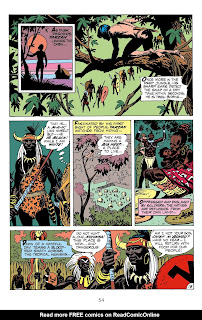 |
| Joe Kubert |
To this end, therefore, he collected the various arm and leg ornaments he had taken from the black warriors who had succumbed to his swift and silent noose and donned them all after the way he had seen them worn.
About his neck hung the golden chain from which depended on the diamond-encrusted locket of his mother, the Lady Alice. At his back was a quiver of arrows slung from a leather shoulder belt, another piece of loot from some vanquished black.
About his waist was a belt of tiny strips of rawhide fashioned by himself as a support for the homemade scabbard in which hung his father's hunting knife. The long bow which had been Kulonga's hung over his left shoulder.
But of these things, Tarzan did not think. He was worried because he had no clothing to indicate to all the jungle folks that he was a man and not an ape, and grave doubt often entered his mind as to whether he might not yet become an ape.
Was not hair commencing to grow upon his face? All the apes had hair upon theirs but the black men were entirely hairless, with very few exceptions.
True he had seen pictures in his book of men with great masses of hair upon lip and cheek chin, but, nevertheless, Tarzan was afraid. Almost daily he whetted his keen knife and scraped and whittled at his young beard to eradicate this degrading emblem of apehood.
And so he learned to shave rudely and painfully, it is true - but, nevertheless, effectively." ERB-Tarzan Of The Apes, chapter 13. From this very long description, we are told Tarzan has still not taken clothes at this point.
One morning after his strength had returned Tarzan set out for Mbonga's village. On the way, the ape-man happened upon three warriors of which one he captured. "Tarzan dispatched his prisoner quickly and silently; removed the weapons and ornaments, and - oh, the greatest joy of all - a handsome doeskin breechcloth, which he quickly transferred to his own person.
Now indeed was he dressed as a man should be? None there was who could doubt his high origin. How he should liked to have returned to the tribe to parade before their envious gaze this wondrous finery." ERB-Tarzan Of The Apes. Note how this passage hints that Tarzan has never appeared in front of the Mangani clothed.
Thus we can conclude from all these passages from chapter 13 of Tarzan Of The Apes, that the jungle lord is twenty years old when he first takes on a regular form of clothing. We know this because after leaving Mbonga's village, the ape-man returns to the cabin by the sea where he sees a huge sailing ship in the harbor. Aboard is the Porter party. It is stated in both Tarzan Of The Apes and The Return Of Tarzan that the jungle lord is twenty when he sees his first white men.
There is another passage from chapter 26 of Tarzan Of The Apes that helps us conclude the ape-man dressed regularly just short of the Porter party's arrival. When Tarzan and D'Arnot are exiting the jungle they arrive at a small river town. Burroughs informs us, "Gradually he became accustomed to the strange noises and the odd ways of civilization so that none might know that two short months before, this handsome Frenchman in immaculate white ducks, who laughed and chatted with the gayest of them, had been swinging naked through primeval forests to pounce upon some unwary victim, which, raw was to fill his savage belly." ERB-Tarzan Of The Apes.
This would also agree with the statement the ape-man made to the Countess de Coude. "A little more than a year ago I was a naked beast of prey in an African jungle." ERB-The Return Of Tarzan.
ABOUT THE AUTHOR
James Michael Moody is a lifelong fan and collector of Edger Rice Burroughs. Over the past forty-five years, Moody has contributed over two hundred articles to various ERB-related fanzines. He also manages an unauthorized Tarzan blog titled Greystoke Chronologist: James Michael Moody. There, the researcher chronologies the Tarzan books starting in May 1872 (known as the pushback theory) instead of the more accepted date, May 1888.
James Michael Moody also authorizes the action-packed Sci-Fi fantasy adventure Unium series. Pioneers On Unium, published December 31, 2019, Exiled On Unium, published August 25, 2022, and Swordsman On Unium, published on July 15, 2024.














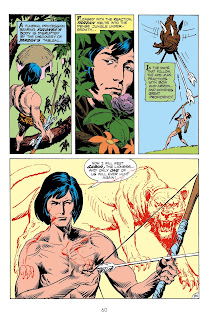
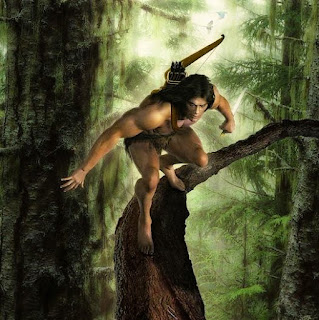
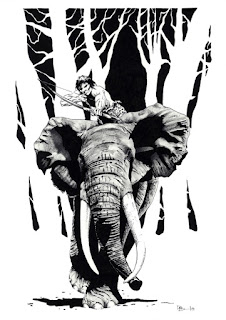
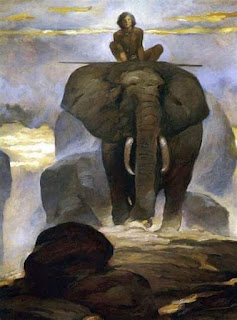




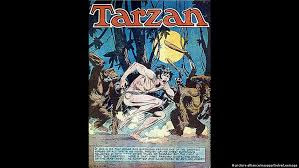

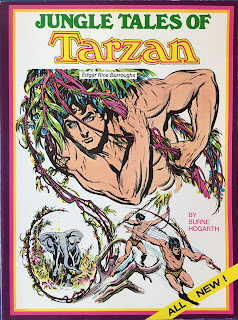
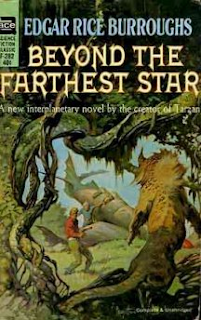
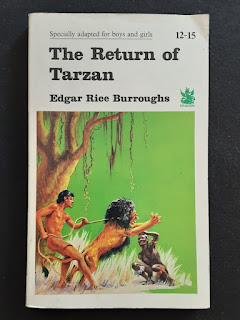



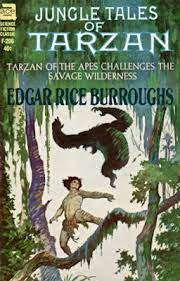

.jpeg)
.jpeg)
.jpeg)
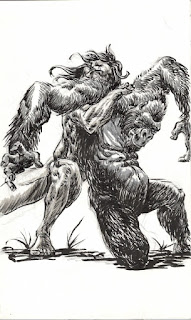
.jpg)




%20Joe%20Kubert-15.jpg)




.jpg)


No comments:
Post a Comment